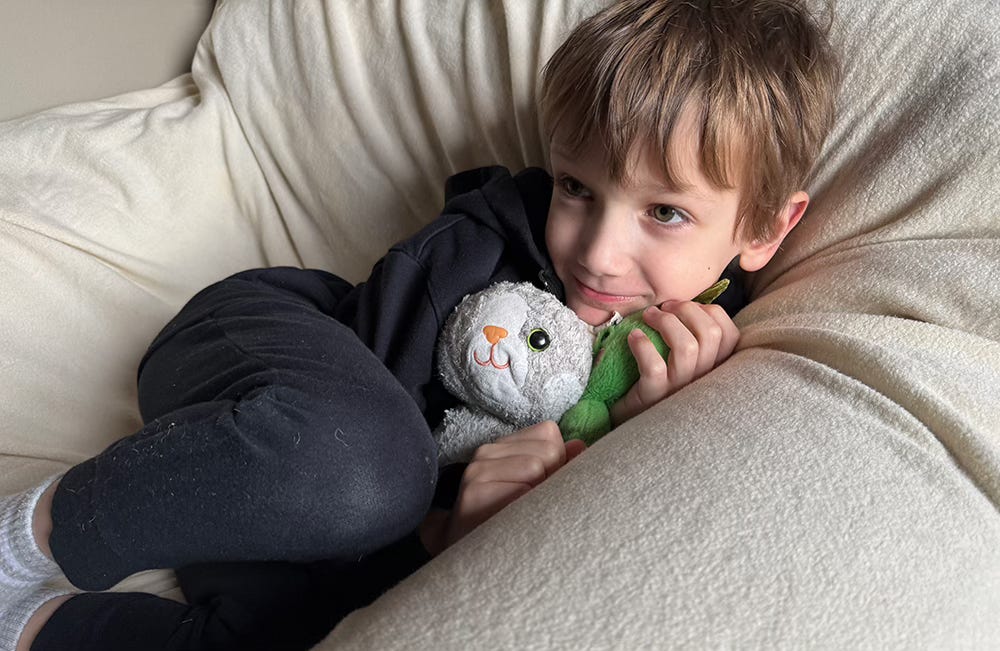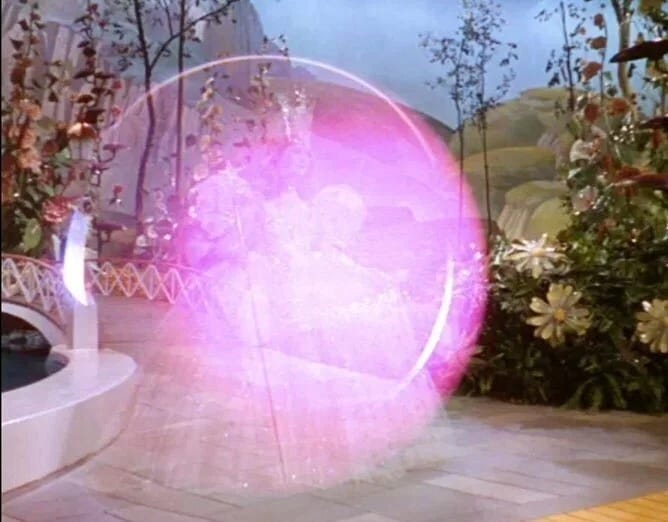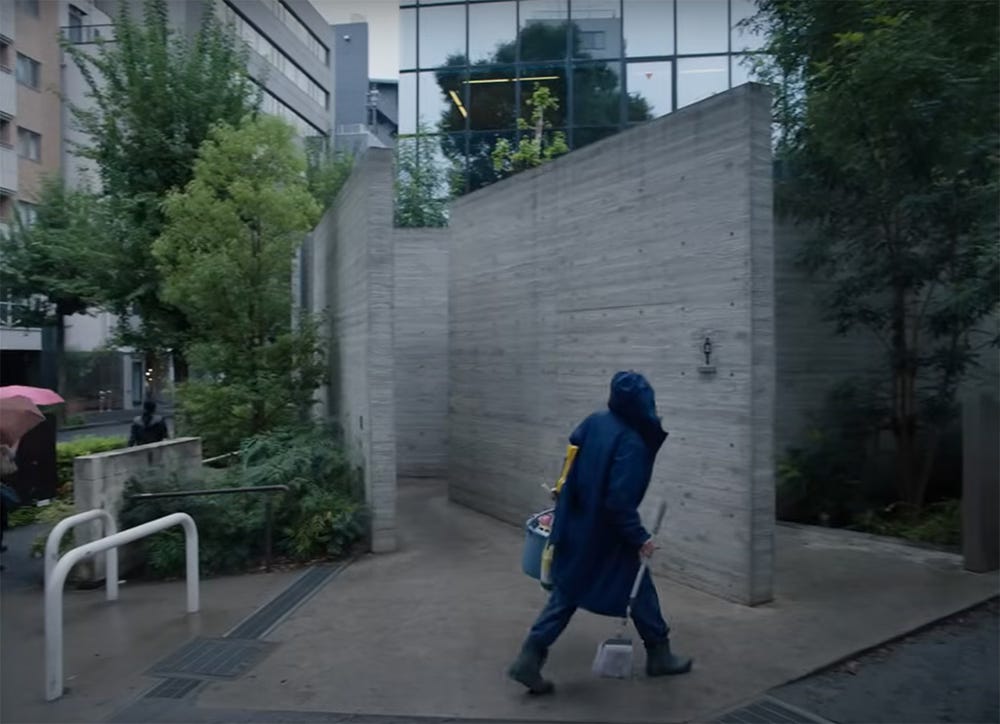Searching for something real
On seeking wonder and connection in a firehose of information and content
The other day I watched The Wizard of Oz with my 8-year-old for the first time. The moment Toto came on the screen, running down the road and across the farm in sync with Dorothy, he asked with wonder, “How did they do that?” He meant, getting the dog to run in these exact ways. Here he is getting cozy just before the movie started:
He couldn’t believe how good the tornado looked, and was convinced the entire farm scene was shot on a real farm. He wanted to know how the Wicked Witch appeared and disappeared in a puff of smoke. When the Tin Man appeared, my son proclaimed, “He looks sooooo real,” as if he was made of real metal.
But more than anything, he was fascinated with Glinda and how she appeared from a bubble.
He kept asking again and again how that happened. I have a small library of books about the Wizard of Oz in my studio, so I showed him one that explained the special effects:
I was considering a similar experience I had with my 15-year old a week earlier. We watched the 2025 Superman movie. At no point did either of us wonder how they got the CGI dog to do anything. While the movie was generally fine, the primary thing I walked away thinking was, “I wish there was less CGI.” From simple things like a CGI plane landing to how characters just didn’t seem real, and thus, not scary. When so many things look fake, to me it removes the sense of stakes in the film. If, as an audience member, you don't feel a sense of the danger trying to be conveyed, how can you become invested in the story?
It made me think back to the rubber suits, matte paintings, miniature models that comprised special effects before CGI. How a movie like the 1982’s The Thing can terrify you with some latex and puppetry. Or how the score of a movie and editing can traumatize an entire generation of people who watched Psycho in 1960. Or how a weird looking rubber alien captured so many people’s hearts (including mine) in 1983’s E.T.
I have this quote that has been hanging on my wall for years now by Fred Rogers (of Mister Rogers fame.) It’s from this section of an interview where he is asked, “Who has made a difference in your life.” Fred’s reply:
“A lot of people. But a lot of people who have allowed me to have some silence. I don’t think we give that give that gift very much anymore. I am very concerned that our society is much more interested in information, than wonder. In noise, rather than silence. How do we encourage reflection? Oh my this is a noisy world.”
That interview is from 1994. More than 30 years ago. Before the internet took hold of our lives.
It’s easy to feel that we don’t have agency here. That we are all swimming against an unrelenting tide of things we must contend with. My days are spent with writers and creators, those who are crafting their work because they are driven to do so. There are stories and ideas that they just can’t ignore. It’s easy to feel overwhelmed by all of the stuff — the tools, content, perceived obligations, and all of which is increasing exponentially because of AI.
But then, there is this… a studio tour from artist and author Samantha Dion Baker, where she shows you every detail of her rented 14x18 room. I’ve written about
before in this post. Here are some still shots:It’s a meditation in the value of analog. On the power of physical space. Of art and connection. Yes, she has a computer, printer, and scanner. But most of the room is filled with tactile art tools, or art itself. Even her teenage son has his own corner where he makes clothes on a very impressive modern sewing machine. Do you think it is a coincidence that one of her son’s makes clothes and the other does film photography?
Digital tools allow us to do so much, so easily. There are a wide range of benefits here in terms of access to creative tools, distribution, low (or no) cost to entry, and a vast array of tutorials. I learned Adobe’s suite of tools back in 1999: Photoshop, Illustrator, etc. This is the book I read to learn Illustrator:
At the time, I was saving up for an iMac, and didn’t even own the Illustrator program yet. But I spent months reading this 775 page book, highlighting parts of it, and preparing for the moment I could finally afford the first iMac:
My friends thought I lost my mind. No I knew used Apple products at that time, and the cost (around $1,200) was more than they were paying for a PC. My Mac also wouldn’t run loads of games and programs that they thought were essential.
Something I have been considering is this: with digital tools, we can do so much nowadays. But, must we?
Do we now have too many choices? Aren’t limits essential (or at least helpful) to the creative process?
Are we too swayed by trends and memes that we become enamored with, perhaps to the point where it becomes difficult to see outside of that box?
Have we convinced ourselves that to “fit in,” we have to be on certain channels, creating specific kinds of content, in particular ways? That “followers,” “reshares", and “views” are best measures of success?
Of course, it keeps changing. And we try to keep up. This is exactly the point that my favorite video makes, “Fitting In” by Ze Frank from 12 years ago:
I often talk about the process of putting your creative work in the world as the craft of sharing. That this is a skill you develop and hone. That it should reflect who you are as a unique human being. That it is not really about fitting in, nor is it about standing out. Instead, it is simply about you being you. Learning to express what you create and why in a way that resonates with authenticity.
We are all searching for something that feels real to us. And while there is so much noise in the world, so many distractions, I want to remind you that you have the agency to create the reality for what you create, how you share, and the manner in which you connect with others.
The other week a writer I know recommended I watch the movie Perfect Days. It’s a quiet film that follows the daily life of a man in Tokyo as he attends to his work cleaning public toilets. That’s the movie. Here are some scenes from it:
But of course, the movie is more than that. I like the way this reviewer on Amazon put it:
“I suppose at its simplest, PERFECT DAYS is a demonstration of how an older man, Hirayama, has discovered a life that can be well lived. It may not be my choice of a life or yours, but its possibility implies that we can all find the life that brings us peace and self-fulfillment, even if it’s unconventional or not the easiest of lives. There are charming and sometimes humorous elements in the depiction of Hirayama’s life, and as we learn about him—a “lesson” that, to me, was continually interesting—we’re treated to Tokyo and various secondary characters who are distinctive and seem very real, indeed. And the more the film opens up to include those other characters, the more we learn about Hirayama, every tiny detail almost like a little gem.”
Analog plays a significant role in the film, as the main character’s hobbies include reading physical books, listening to music on cassette tapes, taking photos with a film camera, and growing saplings.
If you are searching for something real in how you share your work and engage with readers, I want to encourage you to focus on your unique voice. On developing a method of sharing that highlights not only what you create, but why. To have your inspiration central to how you share.
If you want to explore working with me, there are two ways I collaborate with writers and creators:
As always, thank you for being here with me.
-Dan
Kids of the Week: setting up a little store in his room.















I'm going to be completely honest: I clicked on this newsletter because I haven't engaged on Substack for ages and I was concerned I'd be forgotten about amongst the masses.
But I am so glad I read this piece fully and absorbed the true meaning of it, not for the sake of engaging, but to actually understand the concept of what is real and that sometimes going back to the basics is what is required in order to make art.
This was such an important newsletter to read. Thank you 💚
Searching for something real also and have begun a series of drawing people reading actual books and writing with pen and paper spotted around the city.
Thanks for the shout out here, Dan, too. Makes me so happy to see my studio highlighted in this way. Craft and analog is what the space is all about!